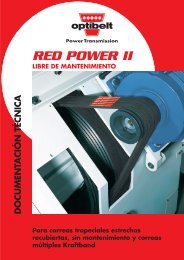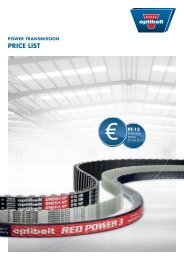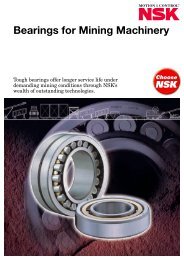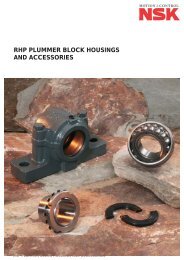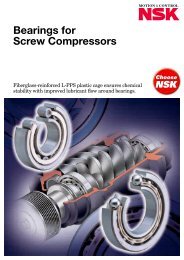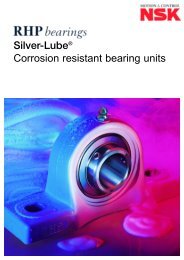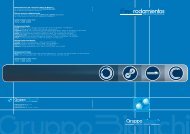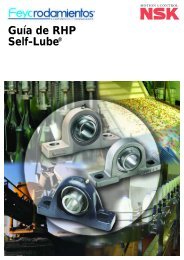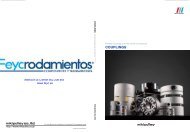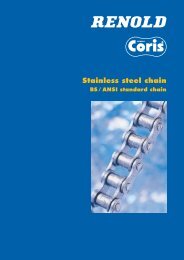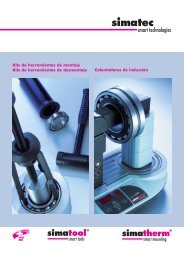Chain
Chain
Chain
You also want an ePaper? Increase the reach of your titles
YUMPU automatically turns print PDFs into web optimized ePapers that Google loves.
Transmission Sprocket Details<br />
Sprockets for Transmission <strong>Chain</strong><br />
Renold manufacture a comprehensive range of stock sprockets for<br />
British Standard chain up to two inch pitch.<br />
Other sizes of sprocket, including those to American Standard<br />
dimensions, are available on request.<br />
Special sprockets are also manufactured on request, in special<br />
materials or formats, normally to suit a specific application in harsh<br />
or difficult drive situations, examples being:<br />
■ Sprockets incorporating shafts.<br />
■ Welded or detachable hubs.<br />
■ Shear pin devices fitted.<br />
■ Necklace sprockets made up of chain plates and individual<br />
tooth sections for turning large drums or tables.<br />
■ Combination sprockets (two or more sprockets combined<br />
having different pitch sizes and numbers of teeth).<br />
■ Sprockets in two or more sections, i.e. split sprockets or<br />
segmental sprockets.<br />
SPLIT<br />
SPROCKET<br />
Sprocket and <strong>Chain</strong> Compatibility<br />
Most drives have an even number of pitches in the chain and by using<br />
a driver sprocket with an odd number of teeth, uniform wear<br />
distribution over both chain and sprocket teeth is ensured. Even<br />
numbers of teeth for both the driver and driven sprockets can be used,<br />
but wear distribution on both the sprocket teeth and chain is poor.<br />
Number of Teeth<br />
The maximum number of teeth in any driven sprocket should not<br />
exceed 114. This limitation is due to the fact that for a given elongation<br />
of chain due to wear, the working pitch diameter of the chain on the<br />
sprocket increases in relation to the nominal pitch diameter, i.e. the<br />
chain assumes a higher position on the sprocket tooth. The allowable<br />
safe chain wear is considered to be in the order of 2% elongation over<br />
nominal length.<br />
A simple formula for determining how much chain elongation a<br />
sprocket can accommodate is 200<br />
N<br />
expressed as a percentage where N is the number of teeth on the<br />
largest sprocket in the drive system.<br />
It is good practice to have the sum of teeth not less than 50 where<br />
both the driver and driven sprockets are operated by the same chain,<br />
e.g. on a 1:1 ratio drive. both sprockets should have 25 teeth each.<br />
Centre Distance<br />
1<br />
NECKLACE<br />
SPROCKET<br />
For optimum wear life, centre distance between two sprockets should<br />
normally be within the range 30 to 50 times the chain pitch. On drive<br />
proposals with centre distances below 30 pitches or greater than 2m,<br />
we would recommend that the drive details are discussed with our<br />
technical staff.<br />
The minimum centre distance is sometimes governed by the amount of<br />
chain lap on the driver sprocket, our normal recommendation in this<br />
circumstance being not less than six teeth in engagement with the<br />
chain.<br />
Minimum six teeth<br />
Selection of Sprocket Materials<br />
Choice of material and heat treatment will depend upon shape,<br />
diameter and mass of the sprocket. The table below<br />
can be used as a simple guide on the correct selection of sprocket<br />
material.<br />
SPROCKET SMOOTH MODERATE HEAVY<br />
RUNNING SHOCKS SHOCKS<br />
UP TO 29T<br />
30T AND<br />
OVER<br />
EN8<br />
or<br />
EN9<br />
Cast Iron<br />
EN8 or EN9<br />
Hardened and<br />
Tempered or<br />
Case Hardened<br />
Mild Steel<br />
Mild Steel or<br />
Meehanite<br />
EN8 or EN9<br />
Hardened and<br />
Tempered or<br />
Case Hardened<br />
Mild Steel<br />
EN8 or EN9<br />
Hardened and<br />
Tempered or<br />
Case Hardened<br />
Mild Steel<br />
The centre distance is also governed by the desirability of using a<br />
chain with an even number of pitches to avoid the use of a cranked<br />
link, a practice that is not recommended except in special<br />
circumstances.<br />
For a drive in the horizontal plane, the shortest centre distance<br />
possible should be used consistent with recommended chain lap<br />
(minimum six teeth) on the driver sprocket.<br />
www.renold.com engineering excellence 67



